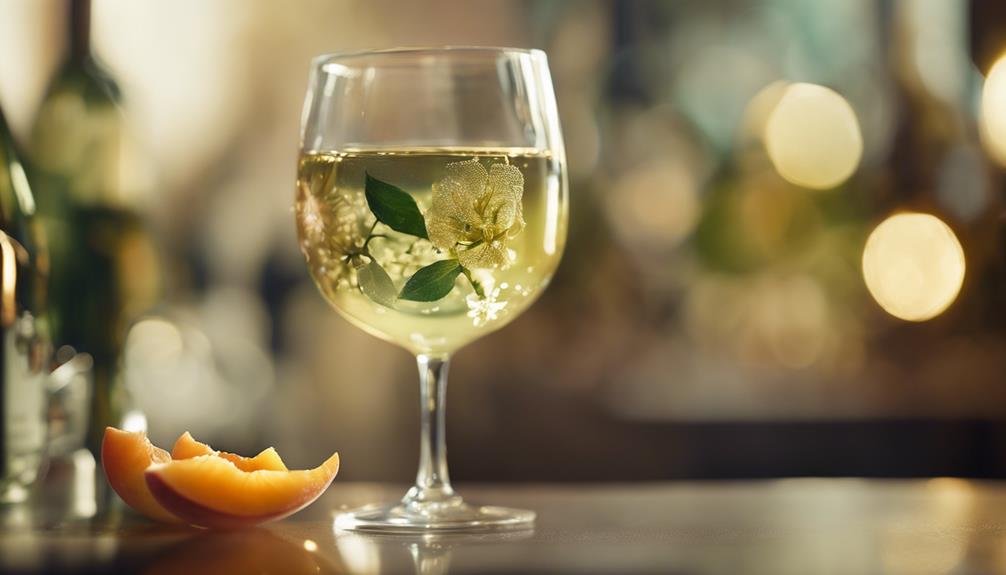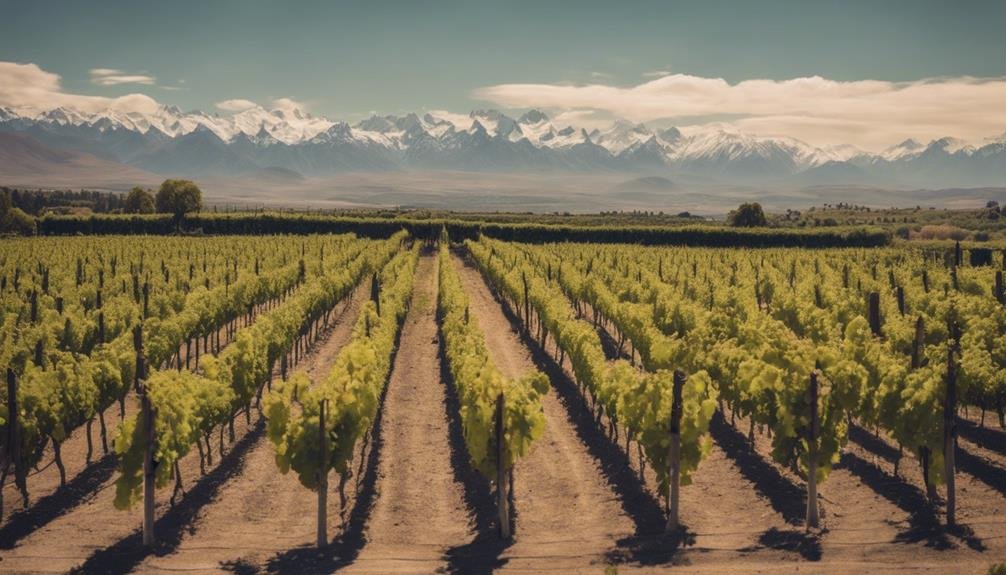Explore the world of Torrontés wine, a delightful blend of floral and fruity aromas hailing from Northern Salta, Argentina. Similar to Riesling and Muscat Blanc, it offers versatile options for white wine enthusiasts seeking a dry and aromatic experience. Taste hints of roses, geraniums, and citrus fruits in this vibrant wine best enjoyed when young. Pair it with spicy dishes, cheeses like Feta or Gruyere, and light meats to enhance its floral and citrus notes. Discover the unique flavor profiles shaped by the terroir influence in Northern Salta. The journey into Torrontés promises a sensory adventure filled with aromatic nuances.
Torrontés Wine Characteristics

Torrontés wine exhibits a distinctive blend of floral and fruit notes, reminiscent of Riesling and Muscat Blanc, making it a versatile option for those seeking a dry and aromatic white wine.
The flavor profiles of Torrontés often include hints of roses, geraniums, and citrus fruits, creating a invigorating and crisp palate. Its aroma notes are typically floral with a touch of tropical fruits, enhancing its overall aromatic profile.
Torrontés is best enjoyed young to preserve its vibrant flavors, but some high-quality bottles may have aging potential of up to 3-5 years. For serving, this wine is best chilled to around 45-50°F (7-10°C) to fully appreciate its delicate aromas and flavors.
Food Pairing Tips
When considering food pairing options for Torrontés wine, it is essential to focus on complementing its floral and citrus notes with dishes that enhance its aromatic characteristics. To bring out the best in this delightful wine, consider the following:
- Spicy Cuisine: Torrontés pairs exceptionally well with dishes from the spice route. Its aromatic profile can beautifully balance the heat and flavors of spicy cuisines like coconut curries and Thai spice dishes.
- Cheese Pairings: When it comes to cheese, options like Feta, Gruyere, Swiss, and Paneer harmonize wonderfully with Torrontés. The creamy textures and varying levels of saltiness in these cheeses can elevate the wine-drinking experience, enhancing both the food and wine flavors.
- Light-Colored Meats: Opting for light meats such as poultry, fish, and tofu can complement Torrontés nicely, allowing the wine's floral and citrus notes to shine through.
Torrontés Varieties and Origins

Originating from the beautiful vineyards of Northern Salta in Argentina, the Torrontés wine varieties are esteemed for their distinct characteristics and exceptional quality. The terroir influence in this region plays a significant role in shaping the flavor profiles of Torrontés wines, offering a unique combination of floral and fruity notes.
Cultivation techniques vary among producers, contributing to regional differences in the final product. The three distinct varieties of Torrontés, with Torrontés Riojano being the most popular, are a result of a cross between the mission grape and Muscat of Alexandria.
It is widely acknowledged that the most delicious Torrontés wines hail from Northern Salta in Argentina, where the ideal climate and soil conditions foster the growth of these exceptional grapes.
Expert Insights on Torrontés
An in-depth understanding of Torrontés wines is enriched by expert insights that explore the specific nuances and qualities of this distinguished varietal. When delving into the world of Torrontés, here are some expert insights to take into account:
- Vineyard Tours: Exploring Cafayate vineyards in Salta Province during late spring offers a breathtaking experience, providing a firsthand look at where these exceptional wines originate.
- Tasting Notes: Torrontés, a group of three distinct varieties, showcases its most popular variant, Torrontés Riojano, known for its unique flavor profile resulting from a cross between the mission grape and Muscat of Alexandria.
- Quality Origins: The most delicious Torrontés wines are often found in the Northern Salta region of Argentina, renowned for producing exceptional varieties that captivate with their aromatic and flavorful characteristics.
About Madeline Puckette

Madeline Puckette, a James Beard Award-winning author and Wine Communicator of the Year, is a prominent figure in the world of wine education and appreciation. Co-founding Wine Folly, she has dedicated herself to helping people learn about wine through accessible and engaging content.
Puckette's expertise in the industry provides valuable insights into the intricate world of wine, making complex concepts more understandable for enthusiasts and novices alike. Her passion for wine education shines through in her work, offering a wealth of knowledge that enhances the understanding and enjoyment of wine.
Through Wine Folly, Madeline Puckette continues to be a driving force in providing industry insights and educational resources that empower individuals to explore and appreciate the diverse world of wine.
Frequently Asked Questions
What Are the Key Differences Between Torrontés and Other White Wines?
Key differences between Torrontés and other white wines lie in its similarity to Riesling and Muscat Blanc, often made in a dry style. For comparative tastings, note its distinctive aromatics and flavor profiles. Perfect with spice-infused dishes, poultry, and cheeses like Feta or Gruyere.
Are There Any Specific Regions in Argentina Known for Producing Exceptional Torrontés?
Regions in Argentina known for exceptional Torrontés are Cafayate and Molinos in Salta Province. High-altitude vineyards, unique microclimates, and sandy, rocky soils contribute to the grape's distinct flavors. Vineyard techniques prioritize preserving acidity in the grapes.
Can Torrontés Wines Be Aged, and if So, How Does It Affect Their Flavor Profile?
Aging Torrontés wines can enhance their flavor profiles, offering complex notes of honey, dried fruits, and floral aromas. Pair aged Torrontés with rich poultry dishes or aged cheeses. Cellar recommendations suggest storing in a cool, dark place for up to 5 years.
How Does the Terroir in Northern Salta Contribute to the Unique Characteristics of Torrontés?
Microclimate influences the grape cultivation in Northern Salta, contributing to the unique characteristics of Torrontés. The high altitude, temperature fluctuations, and sandy soils create a perfect environment for this grape variety, resulting in aromatic and vibrant wines.
What Are Some Upcoming Trends or Innovations in the Production of Torrontés Wines?
Innovative techniques and sustainability practices are shaping the future of Torrontés wine production. From experimental vineyard management to eco-friendly winemaking processes, the industry is poised for exciting advancements that promise to elevate the quality and sustainability of this beloved varietal.
Conclusion
To sum up, the world of Torrontés wine offers a delightful journey of flavors and aromas that captivate the senses. With its versatile profile and affordable price range, Torrontés is a gem waiting to be discovered by wine enthusiasts.
As the saying goes, 'don't judge a book by its cover,' Torrontés may surprise you with its complexity and ability to pair beautifully with a variety of dishes.
Cheers to exploring the exquisite world of Torrontés wine!